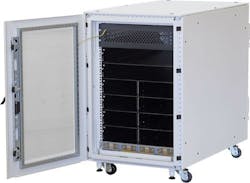A new generation of speed, storage and data processing capacity
Pentair, a global leader in protecting critical processes, people and the environment, presents the new Schroff ServCite rack based on the highly efficient OCP (Open Compute Project) concept. The Schroff ServCite rack has been developed specifically to meet the stringent requirements of the telecommunications industry for shock and vibration resistance, redundancy and reliable cooling capacity. Compared to other standards in the telecommunications industry, such as AdvancedTCA, the Schroff ServCite rack has significantly higher data processing and storage density.
OCP is an industry-wide initiative for defining the specifications and designs for the most energy efficient and economical data center possible. There are, however, additional requirements for environmental and mechanical durability in the telecommunications industry that are not covered in the OCP standard. The Schroff ServCite rack is built on the ideas of the OCP standards and also meets the mechanical and thermal requirements of the telecommunications industry.
The Schroff ServCite rack can accommodate ToR (Top of Rack) switches, a power supply unit with pluggable PSUs, a rack agent as well as shelves for CPU and memory plug-in units (also known as Compute and Storage sleds). The number of compute and storage sleds in use, and thus the computing power or storage density, can vary depending on the requirement. Seventeen Storage Sleds, with the ability to hold up to 24 hard drives with up to 8 TB of storage capacity can be housed in one standard Schroff ServCite rack. If the rack is equipped exclusively with compute sleds, 34 sleds fit into a rack. All Compute sleds can be equipped with two half SSI server main boards, each with two bases. This makes it possible to install up to 136 Xeon processors in the rack.
Heat is dissipated from the components as a result of straight airflow from front to rear and optional backdoor cooling. Conventional 19 inch systems usually require directed air cooling with at least two changes in direction. The straight airflow in the Schroff ServCite rack and the sleds is more efficient and reduces the amount of space needed for redirecting air in the system. That space is then available for additional electronic components.
Furthermore, Pentair's approach with the Schroff ServCite rack follows a new redundancy and reliability concept. While every component requires redundant implementation in conventional systems such as AdvancedTCA, storage and data processing are installed in a Schroff ServCite rack with excess capacity of just 10 percent. If a hard drive, processor, or even a sled fails, the task is simply transferred to another server. Some functions such as the power supply, current conversion and switches still feature 100 percent redundancy.
Pentair offers a wide range of possibilities for customized designs in the selection and specification of a Schroff ServCite rack. This new technology is based on the standard range of highly robust and efficient Schroff Varistar cabinets. The mechanical system of the sleds is based on the modular design of the Schroff Interscale M case with EMC shielding.
For more information, click here

